A walk with my camera.
It was a breathtakingly beautiful spring day in Wetumpka, Alabama. I took a camera along on the dog walk just in case I saw anything worth shooting. And you know what they say...when you have a hammer, all the world's a nail.
Let's start with our bridge. This is Wetumpka's most recognizable feature: the Bibb Graves Bridge, spanning the Coosa river, built by a Dane in 1931 and named after the sitting Alabama governor. If you look closely, you'll see it in the occasional film (the most recent being Big Fish, a surprisingly delightful movie).
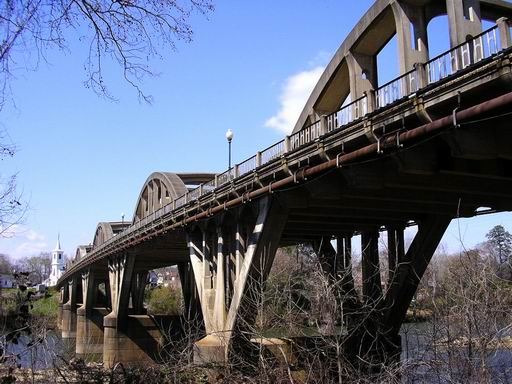
Wetumpka comes from Creek words meaning "rumbling waters," by the way (wee-wau-tum-kau, anglicised to weTUMka, or as the natives here say, WEEtumka). This is the reason for the rumbling waters:
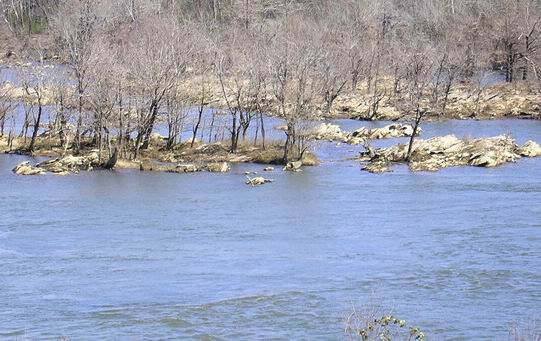
Those rocks, if you look closely, jut up at an odd angle. I recently learned that Wetumpka has the distinction of being the site of a five-mile diameter meteor crater. Geologists always noted that the visibly skewed strata were unusual, and upon investigation discovered that we have very old rocks intermingled with very young ones. Satellite imagery shows a ring of hills where we are, a bit like you see on the moon's surface (but not quite as pronounced). Drilling unearthed what they call "shocked quartz," a mineral only found at meteor craters and nuclear blast test sites. They estimate that the force yielded by the impact was 175,000 times greater than the bomb we dropped on Hiroshima.
Wow.
I imagine I've never heard of this because its timeline doesn't mesh with the accepted age of the earth in Wetumpka. Scientists estimate the impact date at 83 million years ago, and everyone who lives here knows the earth wasn't created until just a few thousand years ago. Stupid scientists.
These turtles really dig the rocks:
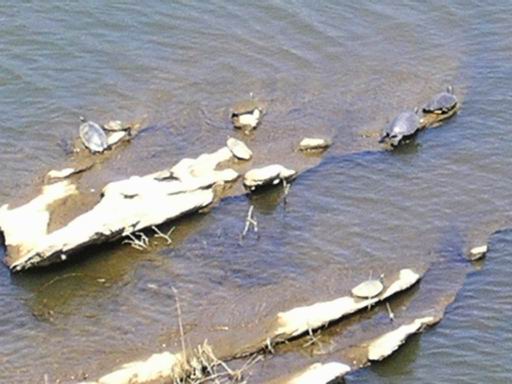
I see this collective of turtles* often when I walk in the middle of the day. (That was shot from the bridge with both the optical and digital zoom maxed out, so the turtles may look a bit fuzzy.) Those are some big turtles, friends. Don't they look happy?
* What do you call a bunch of turtles? Group? Clutch? Bunch? Flock? Covey?
Off the other rail of the bridge, I shot this: 
I've always thought this was a barge dock of some sort. It turns out to be a river "lock" (number 31, to be exact), built in 1898 as part of an ambitious project to make the Coosa navigable from the Tennessee River*. Thanks to war and economic depression and the up-and-coming trains and autos, this lock was never completed and never used. At the very least, it seems useful for fishin' off of, I reckon (there's a group of three or four people on the far right corner).
* Only one person ever managed to navigate a steamer up this far, and it was high water in 1864 and he was high-tailin' it from his Yankee pursuers. It just goes to show you what you're capable of with the proper motivation.
Here's the old jailhouse, visible from the north rail of the bridge: 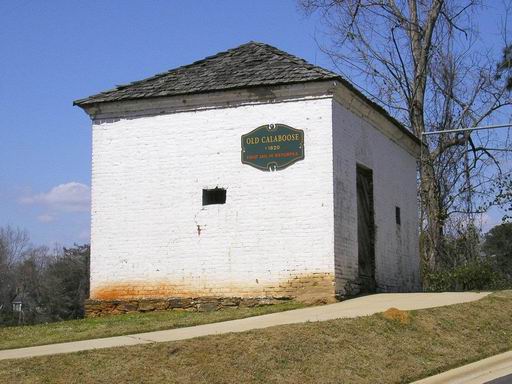
Heated in the summer and air conditioned in the wintertime, I imagine. Circa 1820, it says.
And on my way home, I snapped this, the front of the First Baptist Church: 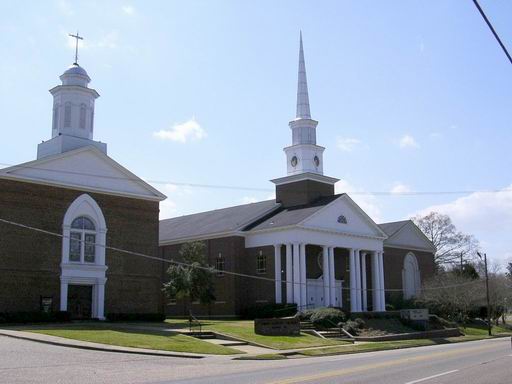
Our little burg is littered with churches, many of them as ancient as the town. I believe this one was founded in the mid-nineteenth century and their original building is still standing and probably functional (although they've obviously upgraded since then). I shot this one because I pass it twice a day and...is it just me, or is their steeple reminiscent of a Ku Klux Klan hood?
Interesting but fairly worthless factoid I recently learned: during the second rise of the KKK, post-WWI, this "secret society" actively recruited members from the pulpit of evangelical churches. Most of this recruited membership came from Baptists, Methodists and Churches of Christ.
This second KKK, though, was intent on reinstilling traditional values in the era of flappers and Prohibition. They wanted their women at home where they belonged (and they wanted other people's women at home where they belonged, too), and were against women drinking and smoking and basically acting like they had minds of their own. They were very down on interracial marriage, as well as men who beat their wives or cheated on them. They still hated blacks, of course (that goes without saying). Generally speaking, though, they were all about moral rejuvination. Considering these goals, I'm not surprised they found such a membership jackpot in evangelical churches.
Maybe it's no accident that that spire looks klannish. Hrm.
I also shot lots of pics of early spring flowers peeping through the dead leaves, but once I shrink them in order to post them on the blog, I'm afraid they'd be reduced to unrecognizable blotches of color, so I'll forego the "hey, it's spring!" shots I'd planned.
d





